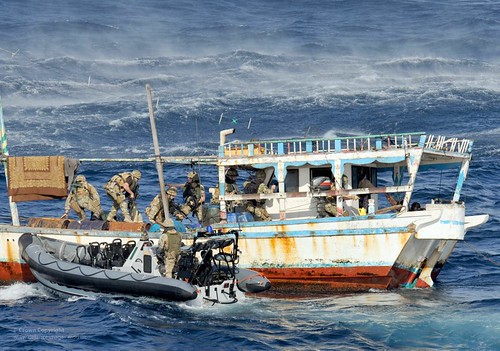
The piracy problem
According to data gathered by the International Maritime Bureau, (attempted) piracy was reported in 77 countries in the period 1998–2009. However, the intensity of the piracy problem varies significantly and the number of pirate hotspots is limited. Countries considered notable piracy hotspots include Bangladesh, India, Indonesia, Nigeria and, most importantly, Somalia.
Since 2005, around 200 ships have been hijacked and held for ransom by Somali pirates. If we consider that each of these ships has a crew of 20, this means that up to 4000 sailors have been taken hostage. Pirates have therefore had a great impact on the level of security in the Horn of Africa and there is some evidence that they have affected both the cost and quantity of shipping through the region.
Location, location, location
Location is everything for Somali pirates. In the shifting patterns of piracy, it is also easy to recognize how these pirates respond to incentives. In the early years of Somali piracy, for example, many ships were hijacked in the seas off Boosaaso. However, with the increase in law and order in Somaliland, piracy nearly disappeared in this area. Why?
There are two important reasons. First, the unrecognized Somaliland Government realized that in order for it to gain respect from other governments (including donors), it needed to do something about the piracy problem. Second, the increase in stability created new and better opportunities for the local population in a safer environment. For example, trade with Yemen has increased significantly over time and living conditions have greatly improved.
At the same time, southern Somalia was too dangerous for pirates for a long time. In order to sustain your piracy operations, it is necessary to acquire many services, varying from local contractors to hire as guards to supplies of the mildly addictive drug qat, which is common to the region, and food for both guards and victims. Southern Somalia is simply too chaotic for this. It was only under the regime of the Union of Islamic Course (UIC) that law and order increased to a level that would theoretically allow for piracy to take place. However, the UIC’s strong anti-piracy stance has deterred piracy in areas they control. The areas in which pirates operate are thus dependent on the incentives provided by the environment. This, in turn, opens up opportunities for combating pirates.
Practice makes perfect
Like many other trades, piracy is something that is learned. There are two specific areas where this becomes particularly obvious. The first relates to the actual acts of piracy. According to the data, minor acts of piracy in one year are associated with more visible hijackings in following years. We see this as evidence of a learning effect. It is also evidenced by the fact that, over time, pirate attacks in Somalia have become more effective and efficient. For example, the use of ‘motherships’ was a major innovation that has since allowed pirates to operate in a much larger area.
The second area in which there is a pronounced learning effect is in bargaining. Ransoms demanded by pirates have increased significantly over time. This is due to the fact that the pirates are learning about the value attached to life by the (often) Western owners of hijacked vessels. The data show that pirates are able to identify reference ransoms, depending on the type and size of ships. As a result, ransom payments that are significantly above the rate common at that time have the impact of increasing ransoms for all future hijackings. Several specific payments stand out. The Spanish vessel Playa de Bakio, for instance, recorded a ransom twice the previous record for a fishing vessel ($1.2 million in 2008) and had a lasting effect on ransoms.
And the winner is …
So, how do we solve the piracy problem? The keyword is incentives. Influencing the incentives of those who accommodate the piracy trade is an efficient way of affecting pirates’ own incentives. For example,pirate havens operate under the protection of local clans that use the hosting of pirates as a way to create employment and make money (through a share of the ransom payments). By co-opting these clans and providing payouts under the condition that no pirated ships are held at such locations, one is able to provide the right kind of incentives to discourage piracy.
Given the impact of piracy on international trade, as well as the costs involved in the military missions in the area, any reasonable payout to these local clans will be a much more cost-efficient way of dealing with the threat of piracy. In effect, this would mean bribing clan elders to bring their incentives in line with ours, but a positive side effect may occur when such payments trickle down into the local economy, thus functioning as informal development aid as well.
This is a cross-post from SIPRI’s Economists on Conflict blog. It has also been posted at the International Network for Economics and Conflict blog, and is part of a collaborative series between Stockholm International Peace Research Institute (SIPRI), Economists for Peace and Security (EPS) and the United States Institute of Peace (USIP).
Olaf De Groot, Deutsches Institut für Wirtschaftsforschung (DIW), Berlin.
For additional reading on this topic please see:
The Role of Seychelles in Counter-Piracy I
Tackling Development and Maritime Security in the Horn of Africa
Long Walk to Restoration: Lessons from Somalia’s Transition Process
For more information on issues and events that shape our world please visit the ISN’s Weekly Dossiers and Security Watch.

